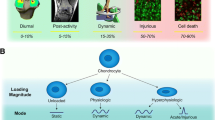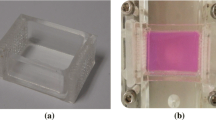Abstract
One of the challenges facing researchers studying chondrocyte mechanobiology is determining the range of mechanical forces pertinent to the problems they study. One possible way to deal with this problem is to quantify how the biomechanical behavior of cells varies in response to changing mechanical forces. In this study, the compressibility and recovery behaviors of single chondrocytes were determined as a function of compressive strains from 6 to 63%. Bovine articular chondrocytes from the middle and deep zones were subjected to this range of strains, and digital videocapture was used to track changes in cell dimensions during and after compression. The normalized volume change, apparent Poisson’s ratio, residual strain after recovery, cell volume fraction after recovery, and characteristic recovery time constant were analyzed with respect to axial strain. Normalized volume change varied as a function of strain, demonstrating that chondrocytes exhibited compressibility. The mean Poisson’s ratio of chondrocytes was found to be 0.29 ± 0.14, and did not vary with axial strain. In contrast, residual strain, recovered volume fraction, and recovery time constant all depended on axial strain. The dependence of residual strain and recovered volume fraction on axial strain showed a change in behavior around 25–30% strain, opening up the possibility that this range of strains represents a critical value for chondrocytes. Quantifying the mechanical behavior of cells as a function of stress and strain is a potentially useful approach for identifying levels of mechanical stimulation that may be germane to normal cartilage physiology, functional tissue engineering of cartilage, and the etiopathogenesis of osteoarthritis.
Similar content being viewed by others
References
Alexopoulos LG, Haider MA, Vail TP, Guilak F (2003) Alterations in the mechanical properties of the human chondrocyte pericellular matrix with osteoarthritis. J Biomech Eng 125:323–333
Athanasiou KA, Thoma BS, Lanctot DR, Shin D, Agrawal CM, LeBaron RG (1999) Development of the cytodetachment technique to quantify mechanical adhesiveness of the single cell. Biomaterials 20:2405–2415
Bush PG, Hall AC (2001) The osmotic sensitivity of isolated and in situ bovine articular chondrocytes. J Orthop Res 19:768–778
Darling EM, Hu JC, Athanasiou KA (2004) Zonal and topographical differences in articular cartilage gene expression. J Orthop Res 22:1182–1187
Freeman PM, Natarajan RN, Kimura JH, Andriacchi TP (1994) Chondrocyte cells respond mechanically to compressive loads. J Orthop Res 12: 311–320
Guilak F, Erickson GR, Ting-Beall HP (2002) The effects of osmotic stress on the viscoelastic and physical properties of articular chondrocytes. Biophys J 82:720–727
Guilak F, Mow VC (2000) The mechanical environment of the chondrocyte: a biphasic finite element model of cell-matrix interactions in articular cartilage. J Biomech 33:1663–1673
Jin M, Frank EH, Quinn TM, Hunziker EB, Grodzinsky AJ (2001) Tissue shear deformation stimulates proteoglycan and protein biosynthesis in bovine cartilage explants. Arch Biochem Biophys 395:41–48
Jones WR, Ting-Beall HP, Lee GM, Kelley SS, Hochmuth RM, Guilak F (1999) Alterations in the Young’s modulus and volumetric properties of chondrocytes isolated from normal and osteoarthritic human cartilage. J Biomech 32:119–127
Knight MM, van de Breevaart Bravenboer J, Lee DA, van Osch GJ, Weinans H, Bader DL (2002) Cell and nucleus deformation in compressed chondrocyte-alginate constructs: temporal changes and calculation of cell modulus. Biochim Biophys Acta 1570:1–8
Koay EJ, Shieh AC, Athanasiou KA (2003) Creep indentation of single cells. J Biomech Eng 125:334–341
Kurz B, Jin M, Patwari P, Cheng DM, Lark MW, Grodzinsky AJ (2001) Biosynthetic response and mechanical properties of articular cartilage after injurious compression. J Orthop Res 19:1140–1146
Leipzig ND, Athanasiou KA (2005) Unconfined creep compression of chondrocytes. J Biomech 38:77–85
Maniotis AJ, Chen CS, Ingber DE (1997) Demonstration of mechanical connections between integrins, cytoskeletal filaments, and nucleoplasm that stabilize nuclear structure. Proc Natl Acad Sci USA 94:849–854
Mauck RL, Soltz MA, Wang CC, Wong DD, Chao PH, Valhmu WB, Hung CT, Ateshian GA (2000) Functional tissue engineering of articular cartilage through dynamic loading of chondrocyte-seeded agarose gels. J Biomech Eng 122:252–260
Patwari P, Cook MN, DiMicco MA, Blake SM, James IE, Kumar S, Cole AA, Lark MW, Grodzinsky AJ (2003) Proteoglycan degradation after injurious compression of bovine and human articular cartilage in vitro: interaction with exogenous cytokines. Arthritis Rheum 48:1292–1301
Putnam AJ, Cunningham JJ, Dennis RG, Linderman JJ, Mooney DJ (1998) Microtubule assembly is regulated by externally applied strain in cultured smooth muscle cells. J Cell Sci 111 (Pt 22):3379–3387
Ragan PM, Badger AM, Cook M, Chin VI, Gowen M, Grodzinsky AJ, Lark MW (1999) Down-regulation of chondrocyte aggrecan and type-II collagen gene expression correlates with increases in static compression magnitude and duration. J Orthop Res 17:836–842
Sah RL, Kim YJ, Doong JY, Grodzinsky AJ, Plaas AH, Sandy JD (1989) Biosynthetic response of cartilage explants to dynamic compression. J Orthop Res 7:619–636
Shin D, Athanasiou K (1999) Cytoindentation for obtaining cell biomechanical properties. J Orthop Res 17:880–890
Smith RL, Donlon BS, Gupta MK, Mohtai M, Das P, Carter DR, Cooke J, Gibbons G, Hutchinson N, Schurman DJ (1995) Effects of fluid-induced shear on articular chondrocyte morphology and metabolism in vitro. J Orthop Res 13:824–831
Smith RL, Rusk SF, Ellison BE, Wessells P, Tsuchiya K, Carter DR, Caler WE, Sandell LJ, Schurman DJ (1996) In vitro stimulation of articular chondrocyte mRNA and extracellular matrix synthesis by hydrostatic pressure. J Orthop Res 14:53–60
Trickey WR, Baaijens FP, Laursen TA, Alexopoulos LG, Guilak F (2006) Determination of the Poisson’s ratio of the cell: recovery properties of chondrocytes after release from complete micropipette aspiration. J Biomech 39:78–87
Trickey WR, Lee M, Guilak T (2000) Viscoelastic properties of chondrocytes from normal and osteoarthritic human cartilage. J Orthop Res 18:891–898
Trickey WR, Vail TP, Guilak F (2004) The role of the cytoskeleton in the viscoelastic properties of human articular chondrocytes. J Orthop Res 22:131–139
Wang CC, Guo XE, Sun D, Mow VC, Ateshian GA, Hung CT (2002) The functional environment of chondrocytes within cartilage subjected to compressive loading: A theoretical and experimental approach. Biorheology 39:11–25
Wang N, Butler JP, Ingber DE (1993) Mechanotransduction across the cell surface and through the cytoskeleton. Science 260:1124–1127
Wang N, Ingber DE (1994) Control of cytoskeletal mechanics by extracellular matrix, cell shape, and mechanical tension. Biophys J 66:2181–2189
Wilkes RP, Athanasiou KA (1996) The intrinsic incompressibility of osteoblast-like cells. Tissue Engineering 2:167–181
Wu JZ, Herzog W (2000) Finite element simulation of location- and time-dependent mechanical behavior of chondrocytes in unconfined compression tests. Ann Biomed Eng 28:318–330
Wu JZ, Herzog W, Epstein M (1999) Modelling of location- and time-dependent deformation of chondrocytes during cartilage loading. J Biomech 32:563–572
Author information
Authors and Affiliations
Corresponding author
Rights and permissions
About this article
Cite this article
Shieh, A.C., Koay, E.J. & Athanasiou, K.A. Strain-dependent Recovery Behavior of Single Chondrocytes. Biomech Model Mechanobiol 5, 172–179 (2006). https://doi.org/10.1007/s10237-006-0028-z
Received:
Accepted:
Published:
Issue Date:
DOI: https://doi.org/10.1007/s10237-006-0028-z




